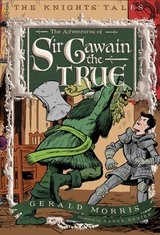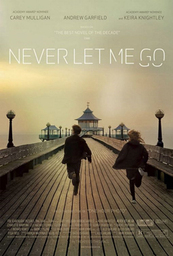
The adventures of Sir Gawain the True (The Knights' Tales, book 3) by Gerald Morris, illustrations by Aaron Renier
Houghton Mifflin, 2011
As a member of King Arthur's court, Sir Gawain is expected to be courteous and honourable. Unfortunately, despite his faultless record in tournaments, Sir Gawain has not quite been living up to expectations. When the mysterious Green Knight shows up at court during Christmas celebrations, Sir Gawain finds himself avowed to him and must keep his word despite the fact that it appears to mean certain death.
This is the third book in Gerald Morris' The knights' tales series, although it is the first one that I have had the pleasure to read. Based on the 14th-century poem Sir Gawain and the Green Knight, The adventures of Sir Gawain the True makes the tale easily understandable to young students, which is not a characteristic of the original if I recall my university English courses correctly. The core of the classic story is kept - the Green Knight's challenge, the woman with her sash, the magic - and the addition of modern humor and charming illustrations certainly accentuate its entertainment value.
I got a kick out of King Arthur as portrayed by Morris: he is determined to have his knights behave honourably and is very patient with them, but is occasionally exasperated. His reactions to his knights' lack of courtesy were often humourous, and his acknowledgments of improvement act as subtle cues to the reader that appropriate behaviour was displayed. After all, adventure aside, many Arthurian tales have morals and lessons within them and this version is no different. However, I didn't feel bonked over the head with a moral, and certainly Sir Gawain wasn't perfect from the beginning but manifested thoughtful and gradual change throughout the story.
The tale itself is a lot of fun, with dwarves, reclusive lords, and jousting all coming into play. Morris' descriptions of period vocabulary, such as damsel and vow, are provided in the text in such a way that they provide information, history, and humour without really bringing the reader out of the story. As a fan of both language and history, I certainly appreciated his incorporation of both into the narrative.
I am hesitant to discuss Aaron Renier's illustrations very much because I read an electronic galley on a Kindle and some of the drawings were split into two, which certainly detracted from my enjoyment of them. However, I did like what I saw despite the fact that Renier drew the knights and King Arthur as older than I envisioned them in my head, which took me aback a bit. That is my only critique (which should be taken with a grain of salt as ages and appearances were never discussed in the text) as the style and content of the illustrations were delightful.
Morris managed to pack a legendary tale into a little over 100 pages which in itself takes great skill, to say nothing of the humour and charm of the text and illustrations. Although I've not read the previous two installments of this series, I will be seeking them out and looking forward to get my hands on them as well as any future books in The knights' tales series.
**Electronic galley provided by publisher via netGalley.
Houghton Mifflin, 2011
As a member of King Arthur's court, Sir Gawain is expected to be courteous and honourable. Unfortunately, despite his faultless record in tournaments, Sir Gawain has not quite been living up to expectations. When the mysterious Green Knight shows up at court during Christmas celebrations, Sir Gawain finds himself avowed to him and must keep his word despite the fact that it appears to mean certain death.
This is the third book in Gerald Morris' The knights' tales series, although it is the first one that I have had the pleasure to read. Based on the 14th-century poem Sir Gawain and the Green Knight, The adventures of Sir Gawain the True makes the tale easily understandable to young students, which is not a characteristic of the original if I recall my university English courses correctly. The core of the classic story is kept - the Green Knight's challenge, the woman with her sash, the magic - and the addition of modern humor and charming illustrations certainly accentuate its entertainment value.
I got a kick out of King Arthur as portrayed by Morris: he is determined to have his knights behave honourably and is very patient with them, but is occasionally exasperated. His reactions to his knights' lack of courtesy were often humourous, and his acknowledgments of improvement act as subtle cues to the reader that appropriate behaviour was displayed. After all, adventure aside, many Arthurian tales have morals and lessons within them and this version is no different. However, I didn't feel bonked over the head with a moral, and certainly Sir Gawain wasn't perfect from the beginning but manifested thoughtful and gradual change throughout the story.
The tale itself is a lot of fun, with dwarves, reclusive lords, and jousting all coming into play. Morris' descriptions of period vocabulary, such as damsel and vow, are provided in the text in such a way that they provide information, history, and humour without really bringing the reader out of the story. As a fan of both language and history, I certainly appreciated his incorporation of both into the narrative.
I am hesitant to discuss Aaron Renier's illustrations very much because I read an electronic galley on a Kindle and some of the drawings were split into two, which certainly detracted from my enjoyment of them. However, I did like what I saw despite the fact that Renier drew the knights and King Arthur as older than I envisioned them in my head, which took me aback a bit. That is my only critique (which should be taken with a grain of salt as ages and appearances were never discussed in the text) as the style and content of the illustrations were delightful.
Morris managed to pack a legendary tale into a little over 100 pages which in itself takes great skill, to say nothing of the humour and charm of the text and illustrations. Although I've not read the previous two installments of this series, I will be seeking them out and looking forward to get my hands on them as well as any future books in The knights' tales series.
**Electronic galley provided by publisher via netGalley.

 RSS Feed
RSS Feed